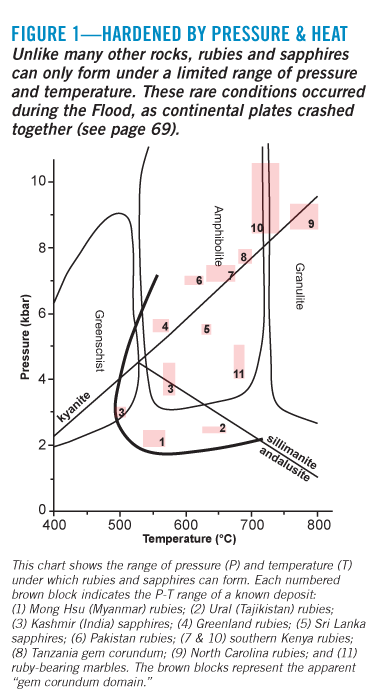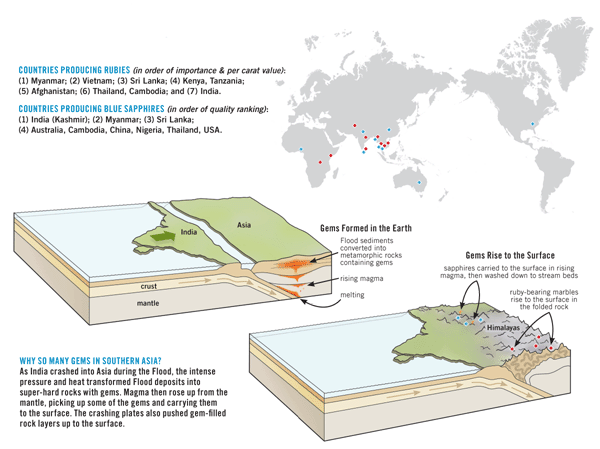
Rubies & Sapphires—Sparkling Reminders of God’s Judgment
Diamonds may get all the attention, but rubies and sapphires are the first choice of kings and the affluent because of their extreme rarity. Only special conditions, initiated by the Flood, could have produced these rare beauties.
In our culture most attention is focused on the glamour of diamonds, but two colorful gems—rubies and sapphires—are actually much rarer and more valuable. God’s Word gives these two stones special attention. Indeed, rubies and sapphires are mentioned more often than diamonds.
For example, Job claims, “The price of wisdom is above rubies” (Job 28:18; see Proverbs 3:15). Interestingly, John lists a sapphire but not diamonds among the foundation stones of the New Jerusalem (Revelation 21:19–20).
Since no one was present to observe how these precious gems formed, creation geologists are carefully investigating the chemistry of the gems and the “crime scene” where they are found. With these clues, along with the Bible’s history of the earth, these sleuths have reconstructed an amazing story of these gems’ origin.
What Are Rubies and Sapphires?
Rubies and sapphires are varieties of the same mineral, called corundum. This hard mineral, composed of aluminum and oxygen (Al2O3), comes in many different forms and degrees of clarity. Only the rarer, clearer crystals are classified as rubies or sapphires, based on their color.1
Of most interest is the source of corundum’s hardness. Corundum is the second hardest natural mineral, after diamonds. Because of its hardness, corundum is used as a natural grinding material, called emery in powdered form. (Emery is commonly found in emery boards—the disposable files used to trim fingernails.)
Great heat and pressure were required to transform the original source materials into this hard mineral. Such an amazing transformation must have occurred in the heat of the earth’s interior, but where and when?
Where Are Rubies and Sapphires Found?

The modern location of rubies and sapphires gives us a clue about the place of their formation. We find them in only a few places, mainly southern Asia and eastern Africa. What took place inside the earth to form these gems and then transport them to the surface?
The answer varies from place to place, but the basic story remains the same. At some point in the past, source rocks inside the earth’s crust were subjected to intense pressures and high temperatures, causing the atoms to recombine into new metamorphic (“changed”) rocks, which included rubies and sapphires. Later the moving crustal plates and erupting volcanoes carried these rocks to the surface.
The details differ in each place. Some rubies and sapphires are found in high-grade metamorphic rocks, called gneisses and granulites, located in Sri Lanka, India, Madagascar, and eastern Africa. In most cases, they formed at depths of 6–18 miles (10–29 km) in the earth’s crust, as intense pressures and high temperatures (above 840°F [450°C]) transformed sedimentary (“water deposited”) rocks, such as siltstones and shales, into metamorphic rocks (Figure 1).2
The best rubies, however, are found in marbles, particularly at mines in Myanmar but also in Vietnam, Afghanistan, Pakistan, and Nepal.3 These marbles formed when heat and pressure inside the earth changed, or “metamorphosed,” soft limestone.
Sapphires are most commonly found in stream beds and other secondary deposits.2 To get there, the nearby rocks must have eroded away and washed down to their current location. The nearby rocks are made of basalts (rocks that came from basaltic magma in the upper mantle). We might assume that these basalts are the original source of the gems, but they don’t have the right chemistry. So where did these sapphires originate? They must have formed in the metamorphic rocks located in the earth’s crust, above the mantle. When the basaltic magma rose up though the crust, it “captured” the gems along the way. The magma then carried the gems to the surface. Later, as water and other natural forces broke down the basalts, the sapphires were released into alluvial deposits, where they are now mined.
When Were Rubies and Sapphires Formed?
We know the composition of these gems and their location. But what special conditions could have created them in the first place and then moved them to the surface?
Geologists have noticed that ruby and sapphire deposits are closely linked to major earth movements.4 Furthermore, they have identified three distinct episodes when these gems formed. These findings help us to place ruby and sapphire deposits at the correct times within the biblical Creation-Flood framework of earth history. The global Flood of Noah’s day, in particular, involved a series of catastrophic plate movements that would explain these gems.5
The first episode was early in the year-long Flood catastrophe, when the African and Indian fragments of the pre-Flood supercontinent Rodinia rapidly collided.6 Pre-Flood and early Flood sedimentary and igneous rocks were buckled, squeezed, and heated, transforming them into the metamorphic gneisses and granulites that host the ruby and sapphire deposits of eastern Africa, Madagascar, India, and Sri Lanka. Then, according to the biblical model of earth history, when rapid crustal plate movements were quickly slowing down at the end of the Flood, the Indian plate collided with the Eurasian plate to form today’s Himalaya mountains. Limestones that had been deposited early in the Flood were then metamorphosed into the ruby-containing marbles of Myanmar, Vietnam, Nepal, Pakistan, and Afghanistan.
During this same period, and extending into the early post-Flood era, residual hotspots in the earth’s upper mantle generated pockets of molten basalt around the globe. When the continental plates, now moving much more slowly, drifted over this molten basalt, the basalt magmas squeezed explosively through the fractured crust, erupting within hours as volcanoes at the earth’s surface.7 As this magma passed through the fractured metamorphic rocks, it plucked rock pieces and sapphires from the walls and carried them to the surface.
This catastrophic activity lasted through the final stages of the Flood and on into the post-Flood era, when new mountains were still rising and volcanoes exploding. Violent weather then rapidly sculpted the new surfaces. Wherever rocks were exposed to weathering and erosion, the indestructible rubies and sapphires were liberated from their hosts and washed into alluvial deposits, later to be mined and enjoyed by man.
Since rubies and sapphires appear to be products of the Flood, we can understand why they aren’t mentioned in the Scriptures until the time of Job. By then, the post-Flood people who scattered from Babel had migrated across Asia to the places where they would find rubies and sapphires.
If this interpretation is correct, the biblical worldview explains why rubies and sapphires are so rare—their formation is restricted to unique conditions when God judged the earth. It also helps to explain why sapphires will be in the New Jerusalem. They are not just pretty reminders of God’s creativity, but they serve as eternal reminders of God’s righteousness, judgment, and mercy. Even today, we can wear such gems as a witnessing tool and as a personal reminder of God’s transforming power on our behalf.
The Value of Rubies & Sapphires

Rubies and sapphires are the most important colored gemstones in the gem trade, together accounting for over 50% of global gem production.1
Rubies are far less abundant than blue sapphires of similar quality and thus are of more value. Flawless, highly prized deep red rubies are seldom larger than three carats, and those that exceed ten carats are extremely rare.
Large sapphires, in contrast, are relatively common, and numerous stones exceeding 100 carats have been found. (A carat is the unit of weight for gemstones, which is now internationally defined as equal to 0.2 gram, or 200 mg, or approximately 0.007 ounce.2)
Transparent raw rubies and sapphires are commonly cut and faceted. Non-transparent stones of fine color are sometimes smoothly polished, not faceted, if there is indication that they might be star sapphires or rubies.
Rubies and sapphires have long been part of human history, dating back to Job, an early post-Babel patriarch around 2000 BC.3 Rubies in particular have been prized by monarchs as a symbol of their wealth and power. In ancient Sanskrit the name for rubies meant “queen of precious stones.” In the seventeenth century the King of Bijapur (now in modern India) owned a ruby that weighed over 50 carats. The German Emperor Rudolph II is reported to have possessed a ruby the size of a hen’s egg.
Rubies are the world’s most expensive gemstones, the best Burmese rubies being valued more than an equivalent-sized flawless diamond.1 The world record paid at auction for a ruby is U.S. $3.63 million in 1988 for a 15.97 carat Burmese ruby (U.S. $227,300 per carat). (By comparison, a 62 carat flawless diamond recently sold for just over U.S. $8 million, or U.S. $130,000 per carat.) The world record paid at auction for a blue sapphire is U.S. $3 million for a spectacular 62 carat rectangular-cut royal blue Burmese sapphire.
Notes
- G. Giuliani, D. Ohnenstetter, V. Garnier, A. E. Fallick, M. Rakotondrazafy, and D. Schwarz, “The Geology and Genesis of Gem Corundum Deposits,” in Geology of Gem Deposits (Short Course Series, Volume 37), ed. L. A. Groat (Quebec: Mineralogical Association of Canada, 2007), pp. 23–78.
- K. K. E. Neuendorf, J. P. Mehl, Jr., and J. A. Jackson, eds., Glossary of Geology, 5th ed. (Alexandria, Virginia: American Geological Institute, 2005).
- H. M. Morris, The Remarkable Record of Job (Santee, California: Master Books, 1988), pp. 12–16.
Answers Magazine
April – June 2010
Debates about evolution and attacks on Scripture seem endless. But why should we be ashamed of truth? In this issue you’ll find basic truths revealed in Genesis and confirmed by science—bare-bones essentials that all Christians need. Also look for fascinating science news, ideas for a faith-building creation “stay-cation” to your local zoo, and semi-technical articles to strengthen your faith and challenge your mind!
Browse Issue SubscribeFootnotes
- The red in rubies is due to trace amounts of the metal chromium, while the blue in sapphires is related to traces of iron and titanium. Some sapphires are yellow or green due to iron atoms (ferric [Fe3+] and ferrous [Fe2+] iron, respectively). W. A. Deer, R. A. Howie, and J. Zussman, An Introduction to the Rock-Forming Minerals (London: Longman, 1971), pp. 405–408.
- C. Simonet, E. Fritsch, and B. Lasnier, “A Classification of Gem Corundum Deposits Aimed towards Gem Exploration,” Ore Geology Reviews 34 (2008): 127–133.
- V. Garnier et al., “Marble-Hosted Ruby Deposits from Central and Southeast Asia: Towards a New Genetic Model,” Ore Geology Reviews 34 (2008): 169–191.
- G. Giuliani, D. Ohnenstetter, V. Garnier, A. E. Fallick, M. Rakotondrazafy, and D. Schwarz, “The Geology and Genesis of Gem Corundum Deposits,” in Geology of Gem Deposits (Short Course Series Volume 37), ed. L. A. Groat (Quebec: Mineralogical Association of Canada, 2007), pp. 23–78.
- A. A. Snelling, “Can Catastrophic Plate Tectonics Explain Flood Geology?” in The New Answers Book 1, ed. K. Ham (Green Forest, Arkansas: Master Books, 2006), pp. 186–197.
- P. Garner, “Time for an Upgrade?” Answers 3.4 (2008): 46–50, 60–61.
- A. A. Snelling, “The Rapid Ascent of Basalt Magmas,” Impact #410, Acts & Facts 38.6 (2007): 10–11.
Recommended Resources

Answers in Genesis is an apologetics ministry, dedicated to helping Christians defend their faith and proclaim the good news of Jesus Christ.
- Customer Service 800.778.3390
- © 2024 Answers in Genesis






